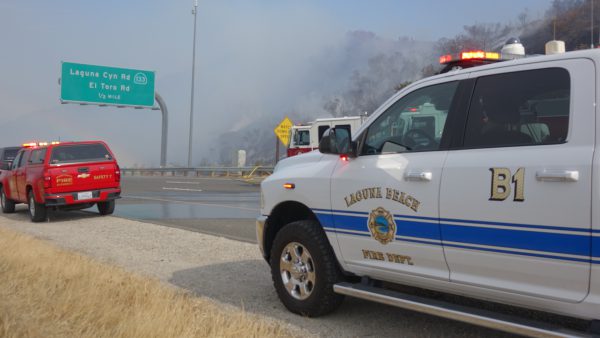
Laguna Beach fire officials on Wednesday heard mixed feedback from residents on proposed wildfire defensible space guidelines, which would essentially blunt the impacts of a new state law requiring some homeowners to undertake drastic trimming of trees and shrubs for fire safety.
Fire Chief Mike Garcia and Fire Marshall James Brown presented the draft guidelines during a workshop in the Council Chambers. Among the more controversial items is a requirement that homeowners in CalFire’s Very High Wildfire Hazard Severity Zone must thin or remove shrubs to no more than 30% ground cover.
Landscape architects have pointed out that this requirement would be unfair to homeowners who have gone through the time and expense to get Design Review Board approval of their landscape design. Some residents have also shared concern that city officials aren’t considering the aesthetic and climate costs of thinning tree canopies to implement new fire safety rules.
“I need to tell you as the fire chief, I think Laguna is a beautiful community, but I’m looking at fire safety,” Garcia said. “It’s a state requirement that this gets done.”
Assembly Bill 28, passed in 2019 but went into effect July 1, requires property sold in high fire hazard zones to document that the property meets wildfire protection measures. If a property falls short of these standards, a home buyer can still close escrow by agreeing to take on the expense of bringing their landscaping into compliance.
By adopting local rules, Laguna Beach could avoid harsher state guidelines such as removing entire trees within 30 feet of a home.
“One of our main things in this document is to not tell someone they need to remove a tree,” Brown said. “We heard from the community and they don’t like that.”
It’s noteworthy that the guidelines extend beyond trimming shrubs and trees. Within five feet of a home, the proposed guidelines include: the underside of balconies and porches should be free of combustible vegetation, organic wood chips and mulch are prohibited, vegetation under windows would be kept to 18 inches tall, and all tree branches must be at least 10 feet away from chimneys, stovepipes, and heater outlets.
If the City Council votes to adopt the ordinance, Brown said fire inspectors would attempt to educate homeowners to get compliance rather than writing citations for at least the first year.
“We’re going to take a fairly soft approach to how we actually do it,” Brown said.
Inspections will be done at no cost for now but with about 300 real estate transactions per year home sellers and buyers will likely need to start paying fees so the Fire Department can hire some part-time inspectors, Garcia said.
Regardless of what Laguna Beach officials decide, mortgage and insurance companies can still require certain homeowners to undertake drastic landscaping removal as a term of service, Brown said.
A local landscape architect pointed out that city law requires property owners who are building new homes to save a certain amount of space for planted areas based on their lot size. He also pointed out that the 30% ground cover limit as written is too vague, adding that a property could safely maintain 100% coverage with short, fire-resistant plants.
Patricia Cooper, a Laguna Beach resident whose Manzanita Drive house burned down in the 1993 fire, encouraged fire officials to press on with defensible space guidelines.
“People need to think would you rather come home to a tree or a house,” Cooper said. “I do hope that you’ll be rigorous in enforcing the codes.”
Realtor Amanda Horton expressed some concern at the prospect of home sellers being asked to bring their property into compliance within 30 days. She suggested fire officials consider offering residents extensions to complete the landscaping work.
“I want to do right by my clients,” she said. “I want to keep Laguna safe.”
Matt Lawson, chair of the emergency and disaster preparedness committee, summed up what’s at stake if the local guidelines aren’t adopted.
“By emphasizing fuel reduction and thinning in the immediate vicinity of structures, these guidelines achieve equivalent fire safety improvement versus the far more draconian state ‘default’ requirements mandating more aggressive vegetation removal over a far larger area,” Lawson said.
A date has not been set for the City Council to consider the defensible space guidelines.





While as a hillside resident next to Laguna’s iconic Greenbelt, I certainly support removing dead trees and prudent thinning, provided we don’t denude our steep terrain to create a Brownbelt. Wildfires have been rare locally with the 1993 Laguna Wildfire an exception due to a slow response time and inadequate water supplies. Fortunately, we can increase wildfire prevention and suppression by utilizing new, independent water resources from the Aliso Creek Water Reclamation Facility at the nearby Coastal Treatment Plant. More reliable, independent water for perimeter Fuel Mod Zones, consistent with the City’s 2005 Fire Department Guidelines, can reduce homeowners insurance rates similar to systems now required in Northern California cities for interior sprinklers. Innovations for improving wildfire safety will emerge when community leaders lead the way.